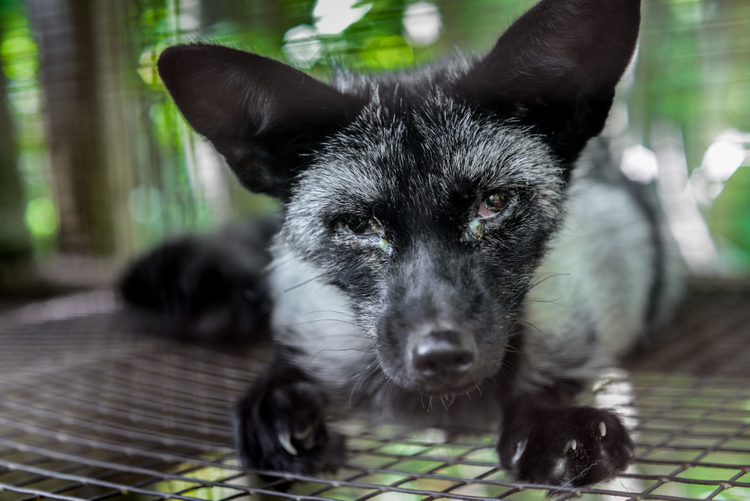Born Free USA, a global leader in animal welfare and wildlife conservation, has published a new report on the fur farming industry in the United States. Titled Silent Suffering in Our Own Backyard: Fur Farming in the United States, the new research highlights serious failings in both animal welfare regulation and oversight and a negligent disregard for public health in light of the recent outbreak of COVID-19 in multiple fur farms in Utah, Wisconsin, and Michigan.
Despite many countries around the world banning the cruel practice of farming animals for the sole purpose of skinning them to use their pelts for clothing, the U.S. has fallen behind and has taken no progressive steps to protect animals from this miserable fate in more than a decade, says Born Free USA. Some states were found to have no regulations at all to provide even minimum protection for animals in fur farms, while others could not even tell Born Free researchers which of their departments of state had responsibility for fur farm oversight and governance.
Angela Grimes, CEO of Born Free USA, says, “In addition to the significant animal suffering involved in fur farming, the fact that we are now seeing concrete evidence of fur farms as a source of COVID-19 during the ongoing global pandemic makes the call to end this cruel industry in the United States all the more urgent. There is absolutely no excuse to have fur in our closets in 2020, and the risk to animal welfare and public health absolutely cannot be justified for such a frivolous purpose as a fashion fad.”
Wearing animal fur as clothing has been steadily falling out of fashion for decades. As members of the public learned about the cruel conditions faced by animals on fur farms, they have turned their back on the practice in droves. A poll released in September 2020 confirmed that only one in four U.S. citizens (25%) are in favor of killing animals for their fur. Aversion to the practice is highest among women (85%).
Concerns over cruelty and decreasing demand have resulted in many major fashion houses, including Armani, Gucci, Michael Kors, Prada Group, and Versace implementing fur-free policies. They join designers such as Diane von Furstenberg, Stella McCartney, and Vivienne Westwood, who are pioneering fur-free high fashion trends. Stores such as H&M, Macy’s Inc., and Zara have also committed to being fur-free retailers, while manufacturers such as Ecopel have filled the gap in the market left by the failing fur industry by creating high quality and sustainable fur substitutes.

Despite the industry downturn, fur farms still exist and animals are still raised and killed in their millions globally; their lifeless bodies discarded and their skins used to make unnecessary coats, hats, or even trinkets on a key ring. More than 85% of fur used in fashion is derived from animals in factory fur farms. Wisconsin is the leading mink producing state, generating more than one million pelts annually, followed by Utah, Idaho, Oregon, and Minnesota. In 2018, there were an estimated 245 mink farms in 22 states producing 3.1 million animal pelts valued at $82.6 million dollars. These numbers only include mink farms; no publicly available records are kept for other species. As such, these figures do not include farms that breed animals like fox, bobcat, nutria, rabbit, and chinchilla and so, the total number of lives taken far exceeds these figures.
Born Free USA investigated the U.S. fur industry in 2009 and published the results in its Cruelty Uncaged report. While other countries have made great strides in closing down the fur farm industry, the U.S. has failed to make progress and the legislative landscape remains almost identical today to what it was in 2009.
Just as concerning as the lack of legislative progress is the seeming confusion surrounding fur farming oversight. In states that have regulations in place to offer a modicum of protection to animals exploited on fur farms, state officials could not provide the most basic information about fur farming in their states and are unsure which government agency is responsible for enforcing the laws.
Grimes adds, “Many states are unaware if there are fur farms in their state, and where those farms are located. This means that millions of animals are suffering unseen, unmonitored, and unprotected in this country. Not only is this an enormous animal welfare issue, but with news surfacing at the time of writing of COVID-19 breakouts in U.S. fur farms, it also presents a significant public safety risk.”
Born Free is calling for an end to fur farming in the United States via the implementation of state-level bans on the practice. In the short-term, transparency regarding the location of existing farms and number of animals held by them is being demanded in the interests of animal welfare and public health.
Download Silent Suffering In Our Own Backyard: Fur Farming in the United States at bornfreeusa.org/silentsuffering
Featured image: mink at an Ontario fur farm. Image credit Jo-Anne McArthur / #MakeFurHistory.





